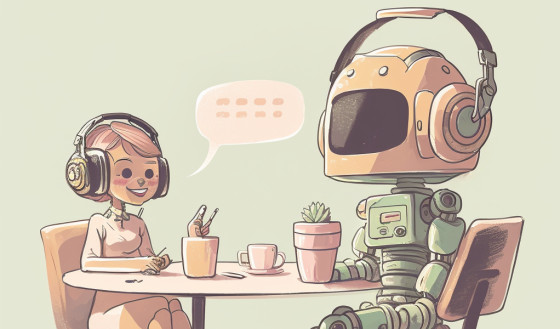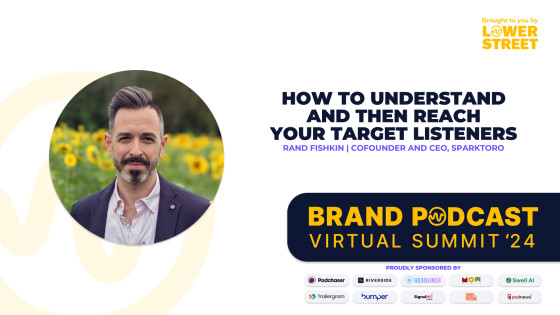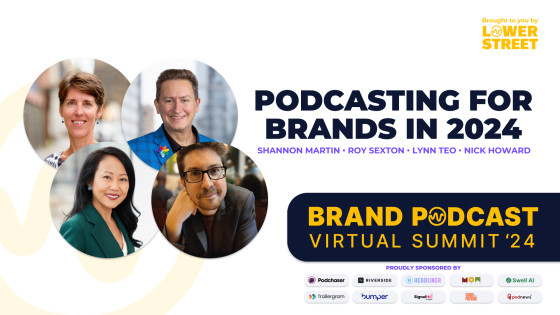When Can AI Make Your Podcast Better? (And When Might It Make It Worse?)
Contents

For podcasters, marketers, and brands, the question isn’t whether to use AI in podcasting. It’s how to use it without losing the magic of what makes podcasts so valuable: the human connection.
At the Brand Podcast Summit, Bridget Todd shared her insights into AI’s role in podcasting. As the creator of There Are No Girls on the Internet and host of Mozilla’s IRL podcast, Bridget brought her expertise in technology, AI, and podcasting. She broke down what AI can do for podcasts, where it falls short, and how to make it work for you. Here’s what we learned.
Who's Listening and What They Want
Podcasts largely attract curious, savvy audiences. People don’t just tune in for mindless entertainment (well, not always). They’re looking to learn and connect, and want to trust the voices they hear. And when it comes to trust, listeners have high expectations. When it comes to brand podcasts, it’s good to know these expectations. Listeners will catch and point out errors, call out misinformation, and quickly dismiss content that feels lazy or fake.
It’s especially the last one you need to consider if you’re thinking of adding AI to your workflow. Remember this: podcasts are intimate. They feel real when done right. Listeners want authentic voices—not cookie-cutter, AI-generated content that feels impersonal or generic.
So, can AI help with podcasting? Absolutely. But it has to be used thoughtfully.
The Reality of AI-Generated Podcasts
AI tools like Google's Notebook LM and Riverside’s voice clones are impressive. They can generate realistic-sounding content, summarize dense information, or even create conversations between AI voices.
Yet, there’s a catch: AI struggles with uniqueness.
Podcasts made with tools like Notebook LM often sound alike. They lack the personality that makes shows stand out. These tools are great for summarizing reports or turning text into listenable audio. But they’re not yet a replacement for human creativity.
As Bridget put it, "If it wasn’t worth your effort as a human, why should it be worth someone else’s time to listen?"
We can use these tools as support to summarize and prepare content but skip them when it comes to the actual creative process.
Practical Ways to Use AI in Podcasting
AI is incredible when it is used as a support, not as a replacement. Here are a few practical ways AI can help your workflow:
1. Editing and Sound Improvement
AI-powered tools like Descript and Riverside can clean up background noise and improve sound quality. They’re especially useful for first-pass edits. However, over-editing can make your show sound a tad robotic. So, that’s where you (or, at least your producer) come in. Keep the edits natural– even if that means leaving in some filler words, extra breaths, or screw-ups. People want to hear humans, not robots.
2. Transcripts and Show Notes
Transcription tools like Otter AI save time and improve discoverability. By posting searchable transcripts and SEO-optimized metadata, you increase the chances of new listeners finding your show through search engines.
Generative AI tools like ChatGPT can also help convert podcast scripts into newsletters or blogs, giving you extra content for your audience. Yet, pay attention here! Don’t just input and let AI do all the work. Your audience is going to see right through a copy-paste method. Whatever the generative AI tool gives you can serve as a base, but make sure to go in with your own edits, to add a human touch to your final content.
3. Brainstorming and Content Ideas
Stuck while planning an episode? AI can be a great brainstorming partner. Tools like ChatGPT can spark ideas or organize your thoughts. But remember, it’s your creativity that makes the final product shine. Use this as a starting point, but don’t rely on it entirely. And don’t forget to collaborate with your listeners to get even more ideas for episodes that will really resonate with your target audience!
4. Assembly Cuts for Narrated Shows
Need to preview how an episode will sound without recording every line? AI voice clones can help.
Add your script and see how it will turn out. But this isn’t your last step. This is a good tip for creating a first draft, before handing it over to your host. It may save you time in the long run if you can adjust the script before recording.
In the final episode, AI voice clones might work for minor pick-ups, but they’re no substitute for a full recording. And when it comes to ads, don’t rely on shortcuts. Listeners (and advertisers) can tell when you’ve phoned it in with an AI voice clone. And your advertisers deserve the authenticity of your real voice (that’s what they’re paying you for!).
Here’s where one of the legal, and ethical considerations comes into play. Todd discussed “recreating” a voice using AI. Whether it’s a deceased public figure or a clone of the host, these practices reveal some of the ethical questions around AI. Who owns the voice? And does replicating it respect the relationship between podcasters and their audiences?
Legally, you cannot clone a voice without explicit permission from the speaker. But even when permission may not be necessary, ethically it’s still very important to have.
5. Social Media Clips
Platforms like Headliner and Opus Clips use AI to help podcasters create shareable clips. However, choosing the best snippet still needs human judgment. AI can handle captions and graphics, but let your instincts guide the storytelling.
Where AI Falls Short
Trust and connection are exactly why people keep listening to podcasts. When podcasts rely too heavily on AI, they risk sounding fake or losing that human touch. For example, AI has a hard time handling humor, subtext, and emotion– things humans excel at.
It’s important to remember that AI creates only as good as what it feeds off of. It gathers information from a lot of low-quality sources out there. When we ask it to create we need to give it a lot of good input, and clear instructions to get what we want out. Even then, always, always, always edit.
Listeners can tell when content feels half-baked or generic. Using AI to churn out low-quality content might save time, but it won’t build trust. People can sense when there’s no genuine effort behind the work.
Moving Forward: For Humans, By Humans
Podcasts aren’t about efficiency or shortcuts, they’re about relationships. It’s okay to use AI tools to make your life easier or enable you to execute your creative vision, but make sure the finished product still feels human. After all, it’s the personal connection that keeps people coming back.
Think of AI as support, not a replacement. Just like synthesizers didn’t replace human musicians, AI isn’t here to take over podcasting. It’s an upgrade to our creative toolbox—a way to work smarter, test ideas, and expand what’s possible in our workflows.
Listeners want podcasts made for humans, by humans. Whether you’re a marketer, producer, or host, don’t fall into the trap of thinking AI is a magic fix. Use it to help, but keep the heart of your content rooted in genuine effort and human creativity.
Final Thoughts
AI isn’t our enemy. In fact, it can do a lot of good…but in this creative and human medium, we need to use it with caution. It can streamline your workflow and help us improve discoverability. But it can’t replace the emotion, personality, and trust that makes podcasts special.
As you start experimenting with AI tools, ask yourself: does this help me create something worth my listeners’ time? If the answer is yes, then AI can be a powerful ally. But always remember—podcasts are for humans. Keep it real, keep it honest, and keep your audience at the center of everything you do.
Ready to start your own podcast?
If you need help creating your branded podcast, contact us today to get started.
Get in touch




